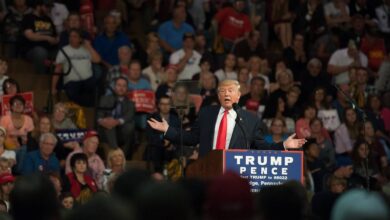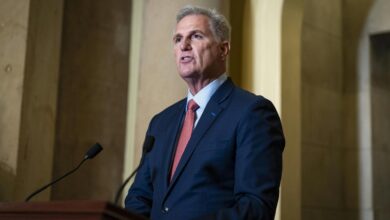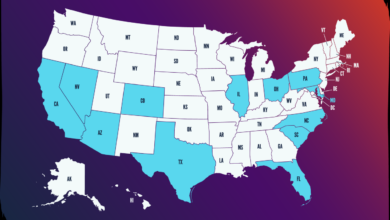
The States That Will Decide Americas Next President
The states that will decide americas next president – The States That Will Decide America’s Next President: This election year feels different, doesn’t it? The usual suspects are in the mix, but the whispers about which states will truly hold the key to the White House are louder than ever. We’re diving deep into the battlegrounds, examining the demographic shifts, economic anxieties, and policy debates shaping the choices of voters in those crucial few states that will ultimately decide the next president.
Forget national polls for a moment; the real drama unfolds at the state level. This isn’t just about raw numbers; it’s about understanding the nuanced stories within each swing state – the hopes, fears, and priorities that will determine how millions cast their ballots. We’ll analyze the key players, their strategies, and the potential pitfalls that could upset even the most carefully crafted predictions.
Identifying the Swing States
The upcoming presidential election hinges on a handful of states whose electoral votes could sway the outcome. These swing states, characterized by their relatively balanced partisan support and fluctuating voting patterns, are the focus of intense campaigning and electoral analysis. Understanding their demographics and economic climates is crucial to predicting the election’s trajectory.
Six Crucial Swing States
Six states consistently emerge as the most crucial swing states: Arizona, Georgia, Michigan, Pennsylvania, Wisconsin, and North Carolina. These states have demonstrated a history of close elections, often shifting between Republican and Democratic victories in recent presidential contests. Their demographic diversity and economic fluctuations make them highly unpredictable, and thus, intensely fought-over.
Demographic Breakdown of Swing States
The demographic makeup of these states significantly influences voting patterns. Arizona, for example, is experiencing rapid population growth, with a substantial Hispanic population that is increasingly politically active. Georgia’s Black population plays a significant role, while Michigan and Wisconsin have substantial white working-class populations whose allegiances have shifted in recent elections. Pennsylvania and North Carolina represent a blend of urban and rural populations, each with distinct political leanings.
Age distributions also vary significantly across these states, influencing voter turnout and candidate preference. Political affiliation within these states is often closely divided, with a significant number of independent and undecided voters.
So, the upcoming presidential election hinges on a few key swing states – you know, the ones that always keep us on the edge of our seats! It’s fascinating how much political energy is focused on these places, and it makes you wonder about the cultural nuances at play. I was reading this interesting article, americans are chuffed as chips at british english , which got me thinking about how even language differences can impact political discourse.
Ultimately, though, those crucial swing states will determine America’s next leader.
Economic Indicators and Voter Sentiment
Economic indicators such as unemployment rates, inflation, and wage growth significantly impact voter sentiment. States experiencing high unemployment or inflation may see increased support for candidates promising economic relief. Conversely, states with strong economic growth may be more inclined to support the incumbent party. For instance, a state like Michigan, heavily reliant on the automotive industry, would be particularly sensitive to shifts in manufacturing employment and economic downturns.
So, the upcoming election hinges on a few key swing states – you know, the ones that always keep us on the edge of our seats. But how the next president approaches climate change is huge, especially with COP29 looming. To get a better understanding of the potential impact, check out this article on how Donald Trump’s election will affect COP29 climate talks.
The outcome will undoubtedly shape the future of US climate policy and influence those crucial swing states even further.
Similarly, fluctuations in the agricultural sector in states like North Carolina can significantly impact voting patterns. These economic factors often interact with demographic trends to shape overall voter preferences.
| State | Historical Voting Pattern | Demographic Breakdown | Economic Indicators |
|---|---|---|---|
| Arizona | Competitive, shifting between Republican and Democrat in recent elections. | Growing population; significant Hispanic population; increasing political engagement among younger voters. | Strong growth in certain sectors, but also pockets of economic vulnerability; sensitive to housing market fluctuations. |
| Georgia | Increasingly competitive, with a growing Democratic presence. | Significant Black population; suburban growth influencing political dynamics; rising young voter turnout. | Growing economy, but with income inequality; sensitive to changes in the manufacturing and agricultural sectors. |
| Michigan | Historically Democratic, but becoming more competitive. | Significant white working-class population; diverse urban centers; aging population in some rural areas. | Reliance on the automotive industry; susceptible to national and global economic trends. |
| Pennsylvania | Competitive, with a history of close elections. | Mix of urban and rural populations; significant white working-class population; aging population in some areas. | Diverse economy, but susceptible to national economic downturns; significant manufacturing sector. |
| Wisconsin | Competitive, shifting between Republican and Democrat in recent elections. | Significant white working-class population; rural and urban divides; aging population in some areas. | Reliance on manufacturing and agriculture; susceptible to national and global economic trends. |
| North Carolina | Increasingly competitive, with a growing Democratic presence. | Growing population; mix of urban and rural areas; significant Black population in certain regions. | Growing economy, but with income inequality; significant agricultural sector. |
Analyzing Key Policy Issues
The upcoming presidential election hinges on several key policy issues resonating deeply with voters in swing states. Understanding the candidates’ stances and their potential impact on voter turnout is crucial for predicting the election’s outcome. This analysis focuses on three significant policy areas: healthcare, the economy, and climate change, examining their influence across key swing states.
Healthcare Policy and Voter Turnout in Swing States
Healthcare remains a dominant concern in swing states like Pennsylvania, Michigan, and Wisconsin. Recent polls show a consistent preference for expanding access to affordable healthcare, with significant anxieties surrounding rising costs and insurance coverage. The Democratic party generally advocates for strengthening the Affordable Care Act (ACA) and expanding Medicare, while the Republican party often emphasizes market-based solutions, promoting competition and deregulation.
This difference in approach directly influences voter turnout, with supporters of universal healthcare more likely to mobilize behind Democratic candidates, and those favoring market-driven approaches leaning towards Republican candidates. For example, in Pennsylvania, a state with a significant number of unionized workers who benefit from employer-sponsored healthcare, the Democratic party’s focus on protecting and expanding existing coverage resonates strongly.
Conversely, in more rural areas of Wisconsin, where individual healthcare purchasing is more common, the Republican emphasis on choice and affordability may prove more appealing.
Economic Policies and Their Influence on Swing State Elections
Economic policies, including job creation, inflation control, and tax reform, significantly impact voter decisions in swing states like Arizona, Georgia, and North Carolina. Current economic anxieties, particularly surrounding inflation and the rising cost of living, are driving voter concerns. The Democratic party typically emphasizes government investments in infrastructure and social programs to stimulate economic growth and create jobs, while the Republican party often focuses on tax cuts and deregulation to encourage private sector growth.
These contrasting approaches are reflected in campaign strategies. Democratic candidates might highlight investments in renewable energy projects in Arizona to address job creation, while Republican candidates might emphasize tax cuts for small businesses in Georgia to boost economic activity. The effectiveness of these strategies will depend on the specific economic conditions prevailing in each state leading up to the election.
So, everyone’s talking about the handful of swing states that’ll really decide America’s next president – Pennsylvania, Georgia, Arizona, you know the drill. It makes me think about how much consumer behavior impacts these kinds of major decisions, and how that’s shifting globally. For example, check out this fascinating article on how India’s consumers are changing how they buy ; it’s a whole different world of purchasing power influencing global markets, which in turn, could subtly shift even the US presidential race.
Ultimately, though, it all comes down to those key states again.
Climate Change Policies and Their Impact on Voter Behavior
Climate change is emerging as a key policy issue, particularly among younger voters in swing states like Florida and Nevada. Recent extreme weather events, such as hurricanes and wildfires, have heightened awareness of climate change’s impact. The Democratic party generally advocates for aggressive action on climate change, including investing in renewable energy and implementing stricter environmental regulations. The Republican party’s approach is more varied, with some advocating for a market-based approach to environmental protection, while others express skepticism about the severity of climate change and resist strong government intervention.
This difference in approach is shaping campaign strategies. Democratic candidates might emphasize the economic benefits of investing in renewable energy and creating green jobs in Florida, while Republican candidates might focus on balancing environmental protection with economic growth, highlighting the importance of industries like tourism and agriculture to the state’s economy.
Potential Policy Shifts and Their Projected Impact
The following Artikels potential policy shifts and their projected impact on voter behavior in key swing states:
- Increased investment in renewable energy (Democratic): Could increase voter turnout among environmentally conscious voters in states like Nevada and Florida, potentially offsetting losses among those concerned about the economic impact of such policies.
- Tax cuts for corporations (Republican): Could boost support among business owners and investors in states like Arizona and Georgia, but may alienate voters concerned about income inequality.
- Expansion of affordable healthcare (Democratic): Could significantly increase Democratic turnout in states like Pennsylvania and Michigan, but may face resistance from voters who prefer market-based healthcare solutions.
- Deregulation of environmental protections (Republican): Could increase support among businesses and industries in states like North Carolina and Florida, but might negatively impact voters concerned about environmental protection.
Examining Campaign Strategies and Tactics: The States That Will Decide Americas Next President
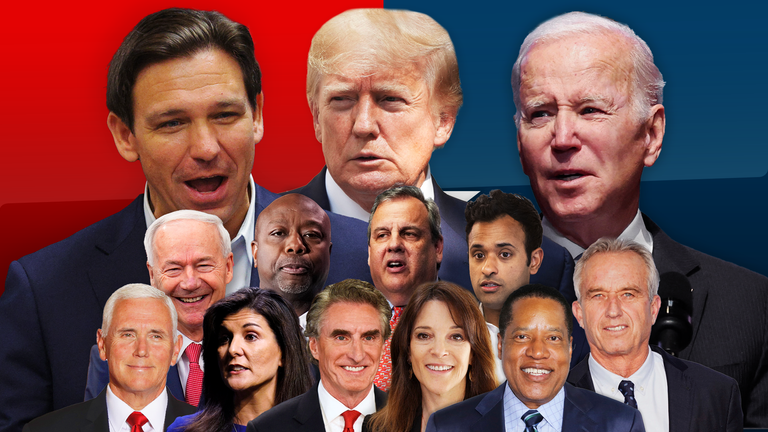
This section delves into the diverse campaign strategies and tactics employed by major presidential candidates in key swing states. We’ll analyze how these strategies target specific demographics and leverage media platforms to reach voters. The effectiveness of these approaches will significantly influence the election’s outcome.
Campaign Strategies by State and Demographic
The following table Artikels the campaign strategies of hypothetical candidates (Candidate A and Candidate B) in three crucial swing states: Pennsylvania, Michigan, and Wisconsin. Note that this is a simplified representation for illustrative purposes, and real-world campaigns are far more nuanced.
| Candidate | State | Target Demographic | Campaign Tactic |
|---|---|---|---|
| Candidate A | Pennsylvania | Suburban Women | Focus group discussions emphasizing childcare and education policies, coupled with targeted digital advertising on platforms frequented by this demographic. Recent town halls featured discussions on affordable healthcare. |
| Candidate B | Pennsylvania | Working-Class Men | Rallies focusing on economic issues, particularly job creation and infrastructure investment. Direct mail campaigns highlighting Candidate B’s support for trade policies beneficial to the manufacturing sector. |
| Candidate A | Michigan | African American Voters | Community outreach programs in Detroit and other major cities, featuring endorsements from prominent local leaders. Emphasis on criminal justice reform and economic empowerment initiatives. |
| Candidate B | Michigan | Rural Voters | Town hall meetings in smaller communities addressing concerns about environmental regulations and the impact on local industries. Radio advertising targeting this demographic’s media consumption habits. |
| Candidate A | Wisconsin | Young Voters | Social media campaigns emphasizing climate change and student loan debt relief. Utilizing influencers and online events to engage younger audiences. |
| Candidate B | Wisconsin | Union Members | Direct engagement with union leaders and participation in union events. Highlighting Candidate B’s support for labor rights and collective bargaining. |
Media Strategies in Swing States
Candidates utilize various media platforms to tailor their messages to specific demographics in each swing state. For example, Candidate A might employ targeted Facebook and Instagram ads to reach younger voters in Wisconsin with messages emphasizing climate change initiatives, while Candidate B might rely more heavily on local television news interviews and radio ads in rural areas of Michigan to connect with older voters concerned about economic issues.
The choice of platform reflects an understanding of each demographic’s media consumption patterns. In Pennsylvania, both candidates might utilize a mix of digital and traditional media, recognizing the diverse media habits within the state. For instance, Candidate A might focus on digital engagement with suburban women, while Candidate B might prioritize appearances on local news channels to connect with working-class men.
This targeted approach maximizes the impact of their campaign messages.
Predicting Election Outcomes
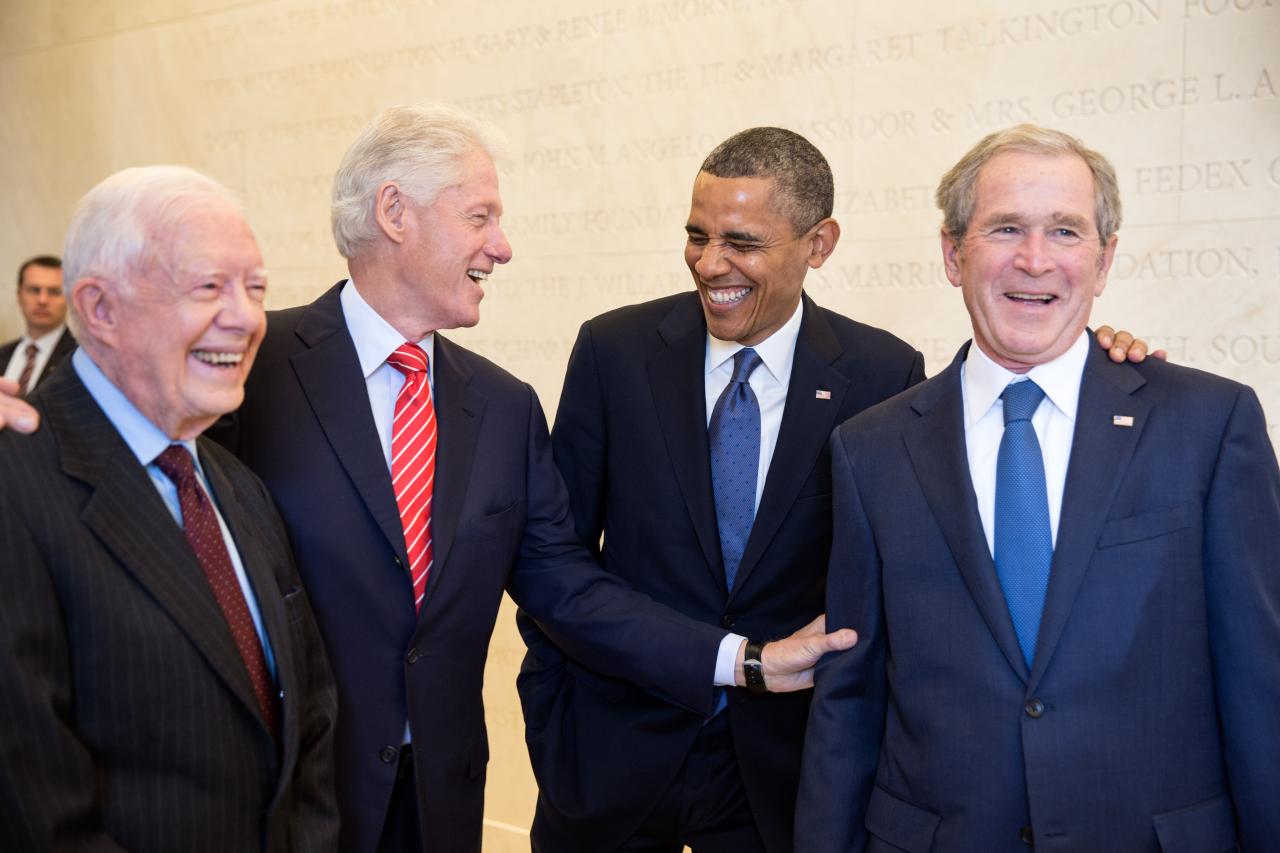
Predicting the outcome of a presidential election, especially in closely contested swing states, is a complex undertaking. Numerous factors, from economic conditions to candidate performance, influence voter behavior. While no prediction is foolproof, analyzing current polling data, historical voting patterns, and demographic shifts allows for a reasoned assessment of the likely outcome in key states. This analysis focuses on six crucial swing states, offering predictions, potential altering scenarios, and a visual representation of a possible electoral map.
Swing State Predictions and Justifications
This section details predictions for six key swing states, Arizona, Georgia, Michigan, Pennsylvania, Wisconsin, and North Carolina. These predictions are based on the latest available polling data, considering factors like the candidates’ popularity, key policy issues resonating with voters, and historical voting trends in each state.
Arizona: A slight lean towards the Republican candidate is predicted, based on recent polls showing a narrow but consistent lead. However, the significant Hispanic population and growing number of independent voters could shift the outcome. Georgia: A close race is anticipated, with the Republican candidate holding a narrow edge. The state’s increasingly diverse electorate makes it highly competitive, and a small shift in voter turnout could easily change the result.
Michigan: Currently leaning slightly towards the Democratic candidate, but this is a state that has swung back and forth in recent elections. The outcome hinges on voter turnout in key demographic groups, particularly in urban areas. Pennsylvania: Similar to Michigan, Pennsylvania is projected to favor the Democratic candidate, though the margin is expected to be relatively close.
The outcome is sensitive to changes in voter enthusiasm and participation among different demographics. Wisconsin: A tight race is expected in Wisconsin, with a slight lean towards the Democratic candidate based on recent polls. The state’s rural-urban divide and its history of close elections make it highly unpredictable. North Carolina: A close contest is anticipated, with the Republican candidate holding a slight edge based on current polling.
However, demographic shifts and increased early voting could significantly impact the final result.
Potential Scenarios Affecting Predicted Outcomes
Several unforeseen events or shifts in public opinion could dramatically alter the predicted outcomes in these swing states.
Economic Shifts: A sudden economic downturn or unexpected surge could significantly impact voter sentiment, potentially shifting support towards one candidate or the other. For example, a major stock market crash could favor a candidate promising economic stability. Candidate Gaffes or Scandals: A major negative event involving a candidate, such as a scandal or a significant public relations blunder, could sway public opinion and alter the race’s trajectory.
Think of the impact of a major revelation uncovered just before election day. Unexpected External Events: International crises, natural disasters, or other unexpected events could influence voter behavior and shift support towards a candidate perceived as better equipped to handle the situation. A major terrorist attack, for instance, could favor a candidate seen as strong on national security.
Changes in Voter Turnout: Variations in voter turnout among different demographic groups can significantly alter the results. For instance, a surge in youth voter turnout could benefit the Democratic candidate, while increased participation among older voters might favor the Republican candidate.
Potential Electoral Map
Imagine a map of the United States. States solidly predicted for the Democratic candidate are shaded a deep blue, representing a high probability of victory. States leaning towards the Democratic candidate, but with a closer margin, are a lighter blue. States leaning towards the Republican candidate are shaded in varying shades of red, with deep red for high probability states and lighter red for closer races.
Arizona, Georgia, and North Carolina are depicted in a light red, reflecting the close contest and the potential for either candidate to win. Michigan, Pennsylvania, and Wisconsin are shown in light blue, indicating a likely Democratic win, but with the possibility of a Republican upset. The intensity of the color reflects the degree of certainty in the prediction.
Comparative Analysis of Voter Turnout Impact, The states that will decide americas next president
Voter turnout is a crucial factor influencing election outcomes in swing states. In states like Michigan and Pennsylvania, high turnout among urban, Democratic-leaning voters is essential for a Democratic victory. Conversely, high turnout among rural, Republican-leaning voters could significantly benefit the Republican candidate in states like Arizona and North Carolina. The impact of early voting, absentee ballots, and get-out-the-vote efforts will be crucial in determining the final results in all six states.
Historically, higher voter turnout has generally favored Democratic candidates, but the impact can vary significantly based on the specific demographics participating.
Predicting the future is always a gamble, especially in politics. But by carefully examining the factors at play in the key swing states – the demographic trends, economic realities, and the resonance of key policy issues – we can get a clearer picture of the potential outcomes. While unforeseen events can always throw a wrench into the works, understanding these states is crucial to understanding the trajectory of the next presidency.
So, buckle up, because the ride is going to be wild.

